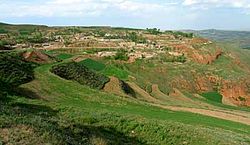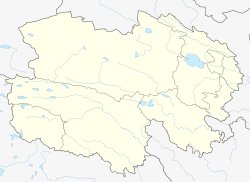
Back Taktser CEB Tagccher Czech Taktser Danish Taktser German Taktser Esperanto تاکتسر Persian Taktser French Taktser Galician Takcer Hungarian Taktser Italian
Taktser
红崖村 Dagcêr Hongya | |
|---|---|
 View of the village of Taktser | |
| Coordinates: 36°22′41.1″N 101°51′57.2″E / 36.378083°N 101.865889°E | |
| Country | People's Republic of China |
| Province | Qinghai |
| Prefecture-level city | Haidong |
| District | Ping'an |
| Township | Shihuiyao Township, Qinghai |
| Elevation | 2,843 m (9,327 ft) |
| Population (2009) | |
| • Total | 256 |
| Time zone | UTC+8 (Tibet Standard Time) |
Taktser or Tengtser (Tibetan: སྟག་འཚེར།, ZYPY: Dagcêr; meaning 'Place on the Heights'")[1] or Hongya Village (Chinese: 红崖村; pinyin: Hóngyá Cūn; lit. 'Redcliff Village') is a village in Shihuiyao Township, Ping'an District, Haidong, in the east of Qinghai province, China[2][3] (also known as Amdo or Kokonor). Tibetan, Han and Hui Chinese people populate the village[4] which is notable as the birthplace of the 14th Dalai Lama, Tenzin Gyatso.
Taktser was originally an area of pasture land for the larger village of Balangtsa, about two hours walk away in the valley. Cattle were brought to feed on the fertile grazing lands in summer, which caused them to give very rich milk. Later, when people realized that this was also a good place to farm, permanent houses were built, and the village comprised about thirty cottages by the time Tenzin Gyatso was born in 1935.[5]
The village is on the route from Xining, which was the seat of local Chinese government administration, to Labrang Tashi Khyi, the largest monastery in the area after the famous Kumbum Monastery.[6]
Taktser is the original Tibetan name[7] of Hongya Village (红崖村; Hóngyá Cūn, Hongaizi in the local dialect),[8] together with 13 other villages forming the Shihuiyao Township (石灰窑乡), of Ping'an County, in Haidong Prefecture.
The brother of the 14th Dalai Lama Gyalo Thondup said that in 1710, a large part of Amdo had been incorporated into the Manchu empire as part of the region known as Qinghai.[9] He also said that people speak a mixture of Tibetan and Qinghai Chinese language.[10] Tibetan researcher Dr. Wang Xiaolin pointed out that at the end of the Ming Dynasty, most of people already spoke the Qinghai Chinese language, and only a very small amount of Tibetan vocabulary was involved. [11] It was reported that the family of the 14th Dalai Lama spoke Chinese at home,[12] and mother of the 14th Dalai Lama spent 2 years to learn the Tibetan language in Lhasa.[13]
Taktser is not, as it is usually taken to be, in the proximity of the Kumbum Monastery, rather it is approximately 27 kilometres (17 mi) east of the monastery, and around 26 kilometres (16 mi) southwest of the town of Ping'an (Chinese: 平安镇, Tibetan: Bayan khar), which is also the seat of the government for the county of the same name.
- ^ Thubten Jigme Norbu, Heinrich Harrer, Tibet is my country, London: Wisdom Publications, 1986, p. 21: "The meaning of 'Tengtser' is 'place on the heights'; that is to say something like 'mountain village', or 'upper village'.")
- ^ 2016年统计用区划代码和城乡划分代码:石灰窑乡 [2016 Statistical Area Numbers and Rural-Urban Area Numbers: Shihuiyao Township] (in Simplified Chinese). National Bureau of Statistics of the People's Republic of China. 2016. Retrieved 13 July 2018.
630203201207 220 红崖村委会
- ^ 石灰窑回族乡 [Shihuiyao Huizu Ethnic Township]. XZQH.org (in Simplified Chinese). 23 April 2013. Retrieved 13 July 2018.
【2011年代码及城乡分类】632121201:{...}~207 220红崖村{...}
- ^ 中国藏学研究中心当代研究所副研究员王小彬 (2013). 十四世达赖的政治生命与西藏的和平解放.
七百多年来,众多民族在这里往来迁徙,逐渐成为藏、汉、回等民族混居地区。清代以来,回族人逐渐成为这条山沟的居民。
- ^ Thubten Jigme Norbu, Heinrich Harrer, Tibet is my country, op. cit., p. 22.
- ^ Tibet is My Country: Autobiography of Thubten Jigme Norbu, Brother of the Dalai Lama as told to Heinrich Harrer, p. 21. First published in German in 1960. English translation by Edward Fitzgerald, published 1960. Reprint, with updated new chapter, (1986): Wisdom Publications, London. ISBN 0-86171-045-2.
- ^ Sonam Dorje. "The First Taktser, Lobzang Dorje b.late 17th cent. - d.early 18th cent". The Treasury of Lives. Archived from the original on 24 February 2015. Retrieved 1 March 2018.
Lobzang Dorje (blo bzang rdo rje) was born in Chikyā Taktse (chi kyA stag mtsher) Village near Kumbum Jampa Ling Monastery (sku 'bum byams pa gling) Monastery some time in the seventeenth century."
- ^ Emily Rauhala, In the Dalai Lama's home town, a moment of limbo, The Washington Post, November 19, 2015: "The spiritual leader was born Lhamo Dondrub to parents who farmed barley and potatoes in the village of Hongya" [...] "his birthplace [is] known to the Tibetans as Taktser."
- ^ Gyalo Thondup; Anne F Thurston (14 April 2015). The Noodle Maker of Kalimpong: The Untold Story of My Struggle for Tibet. PublicAffairs. pp. 3–. ISBN 978-1-61039-290-7.
In 1710, during the reign of the Kangxi emperor, a large part of my native Amdo had been incorporated into the Manchu empire as part of the region known as Qinghai.
- ^ Gyalo Thondup; Anne F Thurston (14 April 2015). The Noodle Maker of Kalimpong: The Untold Story of My Struggle for Tibet. PublicAffairs. pp. 2–. ISBN 978-1-61039-290-7.
The village sits just at the edge of Tibet at a juncture of several cultures - Mongolian, Chinese, Uighur, Tibetan and Hui, with each culture speaking its own distinct language. Much later, as more Chinese moved into the area and we began to intermix, we began speaking a mixture of Tibetan and Qinghai Chinese language.
- ^ Wang, Xiaobin (王小彬) (2013). 十四世达赖的政治生命与西藏的和平解放. 中国藏学研究中心当代研究所 [Contemporary Studies at the China Tibetology Research Center].
早在明末清初,这里的藏族居民已经很难看出他们与当地其他民族有什么不同了。村里人大多说青海汉语,只在生活中涉及少量藏语词汇。
- ^ Wang, Xiaobin (王小彬) (2013). 十四世达赖的政治生命与西藏的和平解放. 中国藏学研究中心当代研究所 [Contemporary Studies at the China Tibetology Research Center].
1941年3月29日,吴忠信日记:"午刻,在行辕宴达赖父母及其两兄弟并童养媳。据云……家人情话均用汉语,决不会忘记……"
- ^ Wang, Xiaobin (王小彬) (2013). 十四世达赖的政治生命与西藏的和平解放. 中国藏学研究中心当代研究所 [Contemporary Studies at the China Tibetology Research Center].
达赖母亲回忆:"那个时候我不会说藏语,花了两年时间才学会了拉萨话。"(英文版第112页)文中提到他们从青海来到热振寺后,会话交流是通过一个叫泽丹的翻译进行的
© MMXXIII Rich X Search. We shall prevail. All rights reserved. Rich X Search

